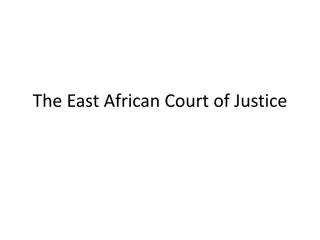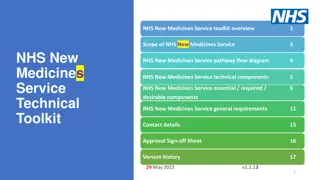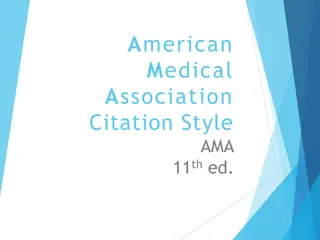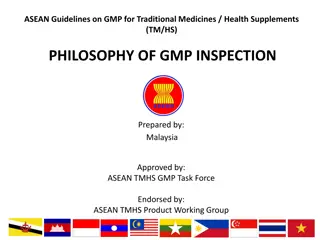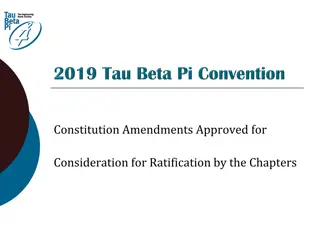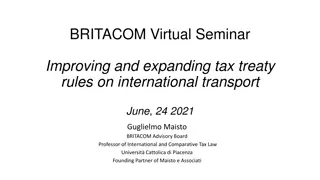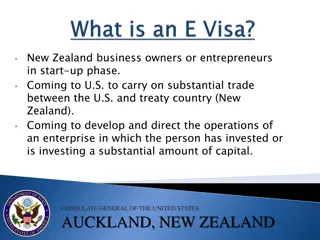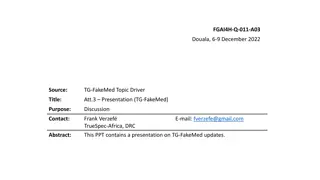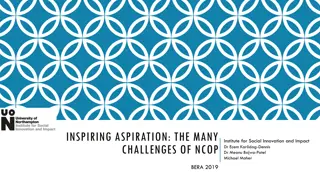African Medicines Agency (AMA) Treaty Ratification Presentation to NCOP Select Committee
This presentation outlines the purpose, strategic importance, background, and value proposition of the African Medicines Agency (AMA) for South Africa. It highlights the urgent need for AMA in addressing Africa's health challenges and the process towards ratification of the treaty. Emphasizing the regional disparities and regulatory issues, the presentation advocates for Parliament's support and approval of AMA to improve access to quality medical products on the continent.
Download Presentation

Please find below an Image/Link to download the presentation.
The content on the website is provided AS IS for your information and personal use only. It may not be sold, licensed, or shared on other websites without obtaining consent from the author.If you encounter any issues during the download, it is possible that the publisher has removed the file from their server.
You are allowed to download the files provided on this website for personal or commercial use, subject to the condition that they are used lawfully. All files are the property of their respective owners.
The content on the website is provided AS IS for your information and personal use only. It may not be sold, licensed, or shared on other websites without obtaining consent from the author.
E N D
Presentation Transcript
PRESENTATION TO THE NCOP SELECT COMMITTEE ON HEALTH AND SOCIAL SERVICES RATIFICATION FOR THE ESTABLISHMENT OF AFRICAN MEDICINES AGENCY (AMA) TREATY DIRECTOR-GENERAL: HEALTH 01 NOVEMBER 2023
PRESENTATION OUTLINE Purpose of the presentation Strategic importance of AMA Background to the establishment of AMA Value proposition of the AMA for SA South African process to sign and ratify the AMA Treaty Vision and Mission of AMA. Objectives of AMA. Key Functions and Focused Areas of AMA Organs of the AMA and Financial Resources. Recommendations
Purpose Purpose To request Parliament to take note of the process undertaken to finalise the process for the ratification of the Treaty for the Establishment of African Medicines Agency (AMA). To request Parliament to support and approve the ratification of the Treaty for the establishment of the African Medicines Agency (AMA), as contemplated in Section 231(2) of the Constitution, 1996, as signed by the Cabinet. 3
AMA: An urgent and compelling requirement for Africa With 17% of the world s population, Africa (55 countries, 1.3 billion people) bears a disproportionate burden of disease: accounts for a quarter of the world s disease burden, 60% of people living with HIV/AIDS, more than 90% of the world s annual malaria cases, Only 6% of the world s health care spending and less than 1% of the world s pharmaceutical market, The Continent produces only 3% of the medicines consumed by its people, Highest prevalence of substandard and falsified medicines (20%), Insufficient access to quality, safe, efficacious and affordable medical products. Largely attributed to weak or absent medicines regulatory systems. Regional Economic Communities (RECs) have different procedures and systems for regulating as well as approving medical products. 4
Background to the Establishment of AMA The establishment of the AMA, was first discussed at the Meeting of African Ministers of Health jointly convened by the African Union Commission (AUC) and the World Health Organisation (WHO) in Luanda, Angola, in April 2014. The focus was to prioritize investment for regulatory capacity development and to pursue the efforts towards convergence and harmonization of medical products regulation at the level of Regional Economic Communities (RECs); The Task Team for AMA was established by the AUC to develop modalities for the operationalisation of AMA and the development of the Treaty on AMA, amongst others.
CONTINUE Following the finalisation of key documents, including the Treaty, consultative meetings with key stakeholders and AU Member States were held in February, March and July 2017 in Midrand - South Africa, Addis Ababa- Ethiopia and Tunis Tunisia respectively. The Treaty was then finalised and adopted by the AU Ministers of Health. At their Working Group Meeting of the Second Specialised Technical Committee on Health, Population and Drug Control (STC-HPDC-2) held in Geneva, Switzerland on 19 May 2018.
. CONTINUE The Treaty was then approved by the AU Specialised Technical Committee on Justice and Legal Affairs in November 2018. The Treaty was adopted by the AU Assembly of Heads of State and Government in their Thirty Second Ordinary Session of 10 11 February 2019, in Addis Ababa, Ethiopia. The AMA Treaty entered into force on 5 November 2021 - after the 15th instrument of ratification was received by the African Union.
Highlights on AMA 27 Members States that have ratified include: Algeria, Benin, Burkina Faso, Cabo Verde, Cameroon, Chad, Republic of Congo, Egypt, Eswatini, Gabon, Ghana, Guinea, Kenya, Lesotho, Mali, Morocco, Namibia, Niger, Rwanda, Sao Tome and Principe, Senegal, Seychelles, Sierra Leone, Tanzania (pending deposit of the instrument of ratification), Tunisia, Uganda, Zimbabwe Governance structures of the AMA established CoSP Bureau of the AMA Ghana Chair of Bureau Governing Board (being established Process ongoing) CoSP constituted and Rules of Procedure adopted. Host country selected and host country agreement signed Rwanda Ongoing process of recruiting the AMA DG (ToRs finalized) o o o o o 8
South Africa: Value proposition of the African Medicines Agency Health Benefits: Improved access to quality assured, safe and efficacious medical products to the population Faster release of innovations to the market Enhanced safety of medical products Accelerated access to medical products in emergencies Improved capability for the countries to review complex medical products and make them available to patients Ability for the continent to deal with cross-border challenges of Substandard and Falsified medicines 9
Cont Economic Benefits Increased economic integration of the African continent though adoption of harmonized standards for regulation of medical products Removal of unnecessary technical barriers to trade in pharmaceuticals in support of African Continental Free Trade Area (AfCFTA). Simplified and less fragmented regulatory processes for industry to navigate thereby attracting investment Access to the continental market for medical products Increased trade and investment in pharmaceuticals by ensuring simplified, less fragmented processes and shorter timelines for registration 10
Value Addition of AMA to SAHPRA and other NRAs Improve efficiency and effectiveness through work sharing and reliance Increased capacity to assess complex medical products Higher visibility on product safety Reduced duplication across NMRAs and RECs Support where expertise gaps Regional harmonization of standards and guidelines leading to more predictable regulatory requirements and improved appetite for investments Reduced duplication across NMRAs 11
Strategic Importance of AMA to South Africa Global and Continental commitments SDGs, UHC agenda, Africa 2063, SADC 2063, etc Access to affordable, high-quality medicines to be healthy and productive throughout the life-course Align with SA policy imperatives: Priority 2 and 4 of the National Development Plan (2030) MTSF (2019-2024): create a conducive environment that enables national priority sectors to support industrialisation and localisation, leading to increased exports & employment Implementation of AfCFTA and other trade agreements in order to grow intra- Africa trade Contribute to the Implementation of identified Agenda 2063 flagship projects Efficient procurement systems to increase access to medicines; Effective regulations and quality control for medicines and medical devices to promote and protect public health (quality, safety and efficacy) 12
South African process to sign and ratify the AMA Treaty Cabinet Memorandum was presented and approved by the International Cooperation, Trade and Security (ICTS) Cluster on 5 May 2022. Cabinet Memorandum was presented and approved by Cabinet. The two Legal Opinions from the Office of the Chief State Law Advisor (OSCLA) (IL) and the State Law Advisers at (DOJCD) were received. Treaty is tabled in Parliament with a clear indication that it is tabled in terms of section 231(2) of the Constitution. Reservation needs to be made in respect of the application of Article 8 as referred to in the legal opinion 13
VISION AND MISSION OF AMA Vision Statement: To ensure that both locally produced and imported medical products for priority diseases/conditions in Africa are affordable and meet internationally recognized standards of quality, safety and efficacy. Mission statement: To coordinate national and regional medicines regulatory systems, carry out regulatory oversight of selected medical products and to promote co-operation, harmonization and mutual recognition of regulatory decisions.
OBJECTIVES OF AMA AMA is established to improve access to quality, safe and efficacious medical products through: a) Coordination and strengthening of ongoing initiatives to harmonize medicines regulation, promote cooperation and mutual recognition of regulatory decisions. b) Carrying out regulatory oversight of selected medical products and providing technical guidance to State Parties and Regional Economic Communities. c) Pooling expertise and capacities and strengthening networking for optimal use of resources.
AMA's Functions and Focused Areas AMA Functions Four focus areas Market Authorization Quality control Inspections AMA Agency Market surveillance Safety monitoring Oversight of clinical trials 16
ORGANS OF THE AMA The AMA shall have the following organs: a) The Conference of the Parties; b) Governing Board; c) The Secretariat; and d) Technical Committees
The Conference of the State Parties (Article 12 - 14) Highest policy making organ of the AMA Composed of Ministers responsible for Health or duly authorized reps of all SPs CoSP meets once every 2 years CoSP shall form a 2-year term Bureau with Chair and 3 Vices and a Rapporteur Bureau meets once a year 18
Functions of the CoSP Set annual contributions by SPs to the budget of the AMA Appoint and dissolve, on good cause, the Governing Board Adopt regulations setting up powers, duties and conditions of service of the DG Approve structure and administrative guidelines of the Secretariat, and governing rules and regulations Provide policy direction for the AMA Location of HQ, rules procedures Approve RCOREs of Board recommendation Recommend amendment of the Treaty to the AU Assembly 19
Functions of the Governing Board Overall: Strategic direction, technical decision-making, guidance & monitoring performance of the AMA Specific: Approve strategic plan, programme of work, budgets and reports Recommend to the CoSP the appointment and dismissal of the DG Appoint and dismiss the independent auditor of the AMA Recommend regulations setting out conditions of service for Secretariat staff Assist secretariat with resource mobilization Establish TCs to provide technical guidance to the AMA Establish rules governing issuance of scientific opinion and guidance to SPs Approve recommendations from the Technical Committees Establish subsidiary or affiliated entities to support AMA functions as necessary 20
Governing Board (Articles 15 19) Appointed and answerable to the CoSP Nine Members of the Board: Five Heads of NRAs - 1 from each AU region One rep of RECs responsible for regulatory affairs appointed by RECs on a rotational basis One rep of RHOs responsible for regulatory affairs appointed by the RHOs on a rotational basis One rep of National Committees Responsible for Bioethics appointed by RECs on a rotational basis The commissioner for HHS AUC 21
AMA Technical Committees (TCs) Permanent or ad hoc established by the Board Responsible for carrying out technical and scientific work of the AMA and providing scientific opinion to facilitate proper functioning of the AMA Not more than nine experts drawn from SPs geographic representation Other experts from across and outside the continent maybe included as necessary ToRs of the TCs to be approved by the Board 22
The Secretariat Responsible for implementing decisions of the CoSP, AU Policy Organs and the Board Coordinate the programme of work of the AMA and all the TCs Prepare strategic plan, programme of work, budget, financial statement and annual reports Secretariat to be headed by the Director General 23
The Director General Appointed by the CoSP on recommendation of the Board to serve as the CEO of the AMA Report to the Board, the CoSP and AU as appropriate, & represent AMA on all matters Appointed for a 4-year term, renewable once Responsible for recruiting staff of the AMA as per the approved structure and procedures A nation of the State Parties of the AMA 24
Financial resources for the AMA (Article 26) Annual assessed contributions from SPs as set up by the CoSP Appropriate sanctions for State Parties that default to be determined by the CoSP in alignment with the AU Assembly sanctions regime Other resource mobilisation mechanisms to include: Grants & donations from international organisation, governments, private sector, foundations and other entities Proceeds from AMA activities Resource mobilisation to be in alignment with guidelines set by the Board and CoSP Pending the adoption of AMA Financial Rules by the CoSP, the AMA shall abide by the AU Financial Rules and Regulations where appropriate. 25
African Medicine Regulatory Harmonization (AMRH) support to AMA operationalisation Technical support building on AMRH technical assets Supporting participation of countries yet to ratify AMA Treaty 26
11 Regional Centres of Regulatory Excellence (RCOEs) 28
RCOEs on vaccines Regulatory Oversight 29
Current Role of South Africa in the AMRH South Africa (SAHPRA) is the current Chair of the AMRH Steering Committee South Africa chairing the continental technical committee on Good Manufacturing Practice (GMP) inspection SAHPRA is a Regional Centre of Regulatory Excellence in Vaccines Regulation SAHPRA currently a lead agency that is hosting the Continental Pilot on Joint Assessment of applications for registration of medicinal products 30
Recommendations Parliament to take note of the process undertaken to finalise the process for the ratification of the Treaty for the Establishment of African Medicines Agency (AMA). Parliament to approve the ratification of the Treaty for the establishment of the African Medicines Agency (AMA), as contemplated in Section 231(2) of the Constitution, 1996.




![Stakeholders' Responses to National Health Insurance Bill [B.11B-2019]: Overview](/thumb/69945/stakeholders-responses-to-national-health-insurance-bill-b-11b-2019-overview.jpg)






